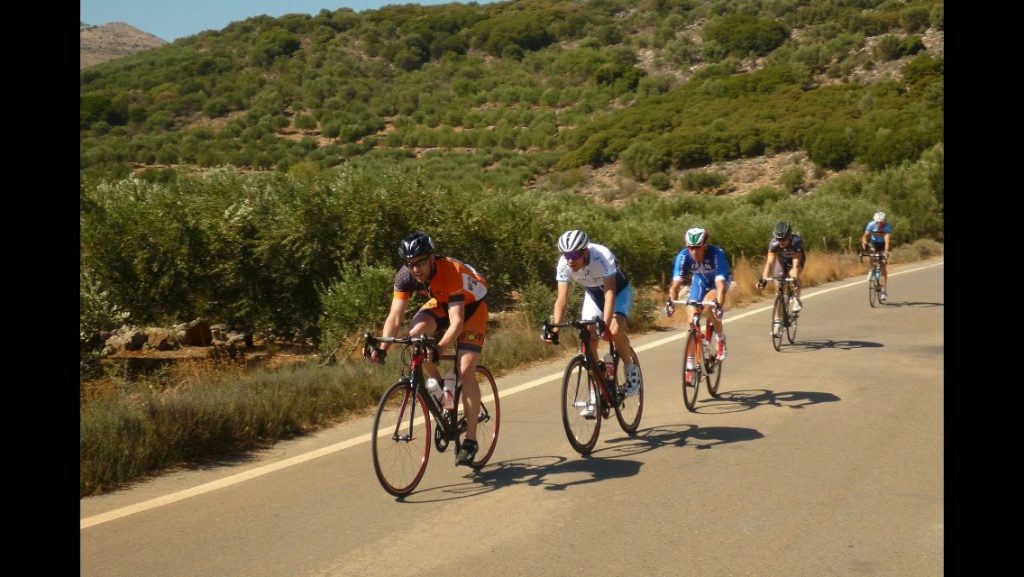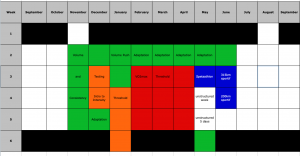
Planning Your Year
Happy New Year Everyone! Hope you enjoyed yourself and are ready to get back to some quality training.
Whatever your goal, you will always benefit from having some structure to your training. Having structure requires a bit of planning. Given the time of year, it’s pretty common to have new goals, resolutions, etc. Whether this is a formal process or just ideas in your mind, it’s useful as long as it leads to positive actions to move you towards your goal.
There’s no one way to do it and everyone is different, but there’s a few things it’s good to consider when planning your year. So today we’ll cover:
- Setting Your Goals
- Outlining Your Year
- Setting up Your Weeks
Setting Your Goals
Hopefully, you have a good idea of what you want to do in broad terms, whether it’s racing-related, distance-related, bike packing, a KOM, a bodyweight/composition goal, etc. However, it’s good to dig a little deeper and know exactly what it is you want to achieve. This makes it far more likely that you will actually do it!! It also helps on days when you need that little extra boost to get things done…if you know what the goal is you are far more committed to the process of getting there.
I have 3 categories I ask people to consider:
- Performance Goals
-
-
-
- These are usually related to events (Road Race, TT, Track, Grand Fondo, Strava Segments, etc).
- Is it a new PB for a 10 mile TT? a win or podium at a crit? To stay with the fast training ride at your club? Get fit enough to enter your first race?
- Really it’s anything, but it has to be something that motivates you to push yourself when the going gets tough because at some point it will, it’s never plain sailing all the time!
-
-
-
- Training Goals
-
-
-
- These are the building blocks of your performance goals, the things that allow you to achieve them. Common things in this category are bodyweight goals, target training hours, skill-related goals, practising things like nutrition on the bike.
- This also relates to the strengths and weaknesses of the individual athlete. What is the gap between where we are and where we want to be for our goal? This allows the training plan to be very specific.
-
-
-
- Other
-
-
-
- I started putting ‘other’ in…because sometimes it’s hard to know where something fits and I really want to know what my riders want to achieve, so it helps if they just write it in…then we know 🙂
- Could be literally anything…not miss time with kids, try a new sport, ANYTHING!!
- If it’s important to you, then it’s important to me…so I want to know.
-
-
-
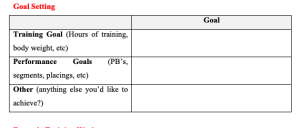
Outlining Your Year
I remember being made to write a year training plan when I qualified as a coach. It was crazy!! It workouts had to show each days workout FOR A YEAR!!!
DON’T DO THAT!!!
Though I think planning so far in advance in such detail is a waste of time, it is good to plan in broad terms to keep you on track. It also allows you to put in your target events. An overview like this is good because you can easily see your time frame to your goal and the relative positions of the goals. It avoids mistakes like having too many events close together, which may compromise results. Mistakes like this are easy to make and an overview calendar is a simple way to avoid it, or at least be aware of it, so you can plan.
I break the year down into week chunks and then fill in the target events…then start planning blocks of training that will get the best results for the athlete.
This doesn’t take long but is invaluable. There isn’t much detail, but I can easily see where we want specific blocks of training. For example a threshold block, a VO2max block, a volume block, adaptation weeks, etc.
More detail than this will be wasted time as too many changes in the average persons life. An increase in family time needed, illness, travel, basically anything can force you to adapt!! But if you have a broad view you know the focus of the week and can adapt the individual weeks’ sessions to be flexible with life, but still working efficiently towards your goal.
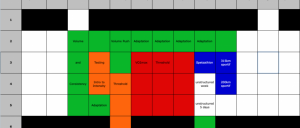
Outlining Your Week
This is where you break down your sessions for the week. The goal in planning is to find a sustainable pattern and volume of training that allows you to be consistent. Consistency is the biggest secret of an endurance athlete. If you start the year all enthusiastic and doing far too much, you can’t sustain it and consistency suffers.
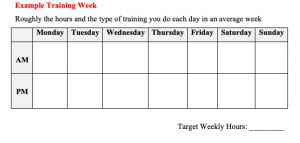 If you fill in this simple. table with when you can train and how much, it’s a good start. Make sure you make it fit in with your work and family life…be honest. Don’t put 4 hours. training rides are. possible every. Saturday and Sunday if it means your partner will want a divorce after a month!! This is not a good training/life balance and will make everyone miserable and. ultimately lead to a bad place. Be realistic and BUILD CONSISTENCY.
If you fill in this simple. table with when you can train and how much, it’s a good start. Make sure you make it fit in with your work and family life…be honest. Don’t put 4 hours. training rides are. possible every. Saturday and Sunday if it means your partner will want a divorce after a month!! This is not a good training/life balance and will make everyone miserable and. ultimately lead to a bad place. Be realistic and BUILD CONSISTENCY.
Summary
This is a great time of year for reflecting on the previous year or years and setting out what you want to do with your riding. You don’t have to spend hours and hours on it, but a small investment of time will make all your training time much more effective, so it is definitely time well spent.
I didn’t talk about how to analyse previous years training/racing, which is a useful step also, but is probably a topic for its own post. I’ll follow up with that soon.
Follow the steps and you’ll be in a great place to achieve new things…
Good Luck in 2022 all, hope it’s a great year 🙂
Make a Plan
With a coach, you are part of a team. Together we make a plan tailored to your goals and your lifestyle
The Work
You still need to do the work. But we’ll be with you, keeping you motivated and on track.

